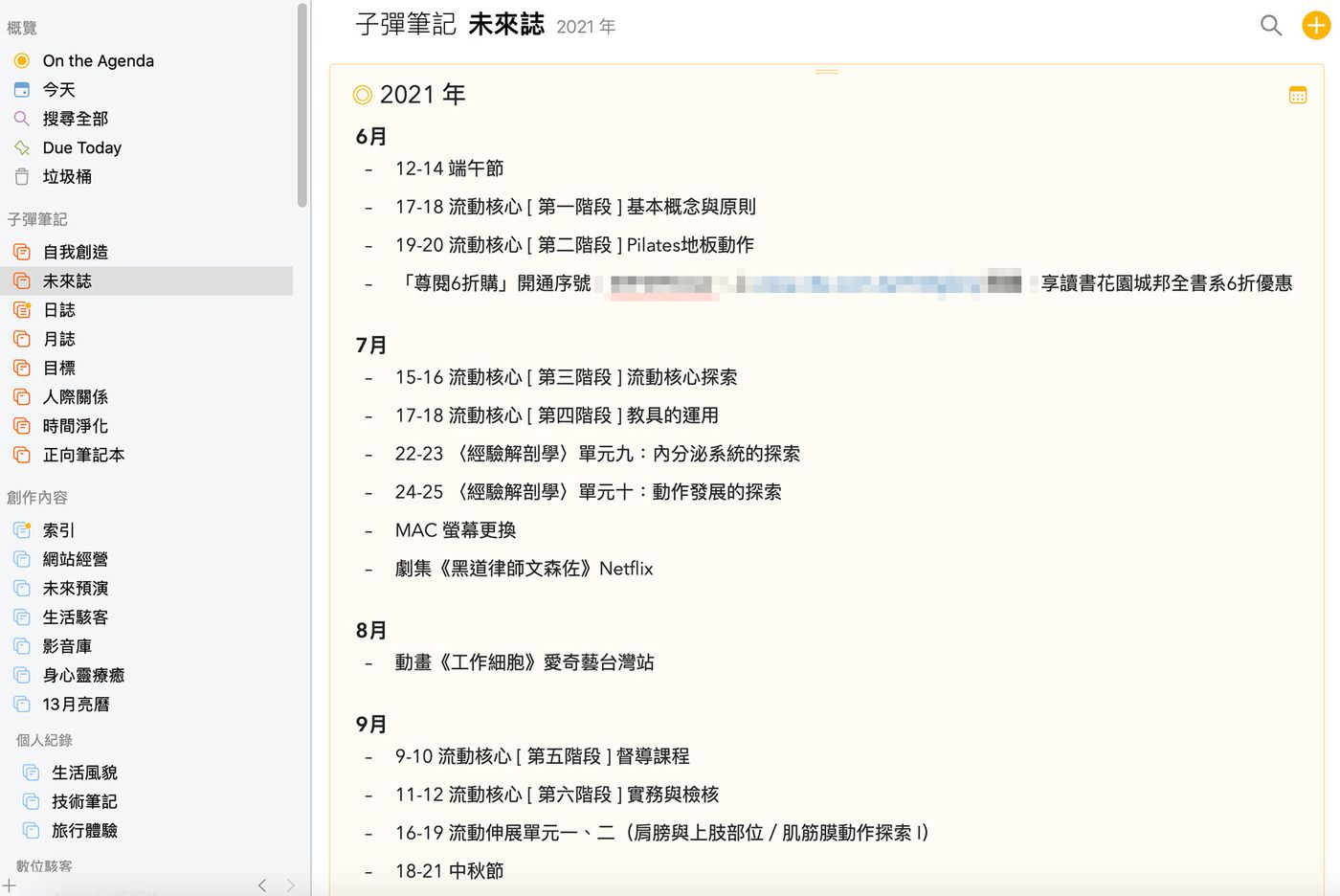My "Bullet Notes" mentality and method: Future Chronicles

As I have said before, journals and monthly journals , this time it is the turn of "Future journals". According to the author , these three main items constitute the prototype of the basic bullet journal.
In fact, when I wanted to write about the future, I found that it was more difficult to write than before, because the word "future" itself represented something that was still uncertain.
The author's original text for the future journal is as follows:
You can think of the future as a queue, the month when each task is eagerly awaited to be completed.
As for the transfer part, I have already explained some of them in the monthly journal , but what I want to focus on here is how did the future journal come from, and what is the process of input and output?
The source of futurism: daily experience
Every day I use Bullet Notes, my log specifications are actually evolving. Some of them are because I want to try the use of different functions of Agenda , and can I make the log more possible. At the same time, there is always something to adjust every day.
But the same thing is, I still regard the concept of "log" as a summary of all the work every day .
This is also the source of the main future records. Every day, information from different sources is included in the log. When this matter is not in this month or next month, the future records are the place to be stored.
Take me as an example, I may have seen many courses that I am interested in, and they will be posted in my journal first. I remember that in addition to the time in the journal, I have set an area called to be scheduled . , will be sorted into future records in chronological order.

Future records are difficult to create based on feeling or the life of the day. When thinking about input, it is very important to rearrange them according to time. Compared with journals, they pay more attention to details. The focus is on "organization".
To organize is to keep the key points and necessary information. Other details should be deleted first, and don't care about how to arrange and lay out.
Because the future ambition is already indicated in the name, this is a matter that "has not come", since the future, we can only know the general outline when entering it.
Output future journal: switch to monthly journal
The monthly journal is different from the journal. The two major elements in the monthly journal are "time schedule by date" and "tasks that need to be scheduled". According to what is said in the book, when the future records are queued up to the time, they will start to be placed in the monthly records.
At the beginning, I would put all the contents of the future journals on the task page of the monthly journal to look at, and then set the date to analyze how to arrange it into different days.

At the same time, it is actually a process of thinking, because when the "project" of the task is to be disassembled into "detailed items" to be executed every day, I will think about two questions:
- The necessity of this task, do I still want to do this thing now?
- How much time do I need to complete? Can it be done in just this month?
Sometimes, come to think of it, the project ends up being deleted. Another possibility is that I think this project is necessary, but I find it difficult to arrange it to be completed in the same month. At this time, this future project should not only be a task, but probably a goal.
If Dangchun is not completed this month, it is equivalent to being converted from the future vision, and it will be divided back into the future vision again. Personally, I think this process is very strange. I think carefully. In fact, I think it is not about skills, but more about mentality.
The "project" of Miku is different from the goal
Although in the bullet notes, the three themes "log", "monthly" and "future" are very emphasized, but my own judgment is that these are all about executing projects, so the content on these three pages should be enough. Explicit, unclear statements, rather than being called projects, are "goals."
The management of executive projects and management by objectives, in fact, are fundamentally two different things.
In terms of production, managing execution projects is that I already know which dishes to make today, so I can buy ingredients (find resources), wash vegetables, chop vegetables, stir-fry vegetables, prepare plates, etc. according to these "dishes". Serve to the table. These are explicit and listable to perform, and that's where bullet journaling comes in handy.
We can write down the projects to be done, and then follow our projects step by step to complete the goals through execution.
In terms of goals, it's like I announced today: "Next, we will start eating fat-reduced meals." Before arranging dishes, it is a relatively distant and relatively vague concept to evaluate concepts and detailed plans.
Therefore, goals are not suitable to be placed in futuristics.
Here are a few ways for me to judge whether it is a project or a goal:
- Can I put a definite date: Without a definite date it is not an executable project.
- Can I complete this project within one month: If it exceeds one month, then it needs to be subdivided into more detailed projects, because the output mentioned above is to arrange the future journal into the monthly journal, so "one month ” is the largest allocation unit.
If after judgment, it is confirmed that the written content belongs to the category of goals, then I will change it to the notes of goal management. Only the executable items are left in Futurology, in line with the core concepts of Bullet Notes: "execution" and "recording".
Summary: Futurism helps us get closer to the distant
Originally, when I was writing the future journal, I paused for a long time, always wanting to say that there is not much to share with you. Unexpectedly, I still wrote more than 1,500 words of content. In fact, among the three major projects of Bullet Notes, Futurism seems to be the simplest.
It suddenly occurred to me that I would have an unconscious little habit, which is to keep the time block of future ambitions within the next twelve months. Be able to have ideas for the year ahead.
From the past educational experience, the future is always said to be far away from us. Futurism can be a good tool. When I see projects one by one, I feel that I am slowly getting closer to that distant future!

Like my work? Don't forget to support and clap, let me know that you are with me on the road of creation. Keep this enthusiasm together!

- Author
- More